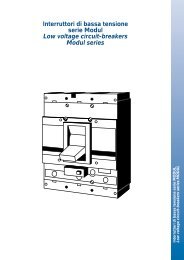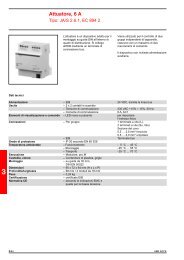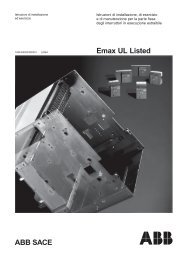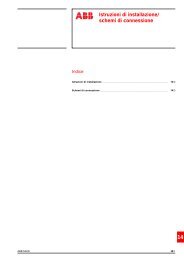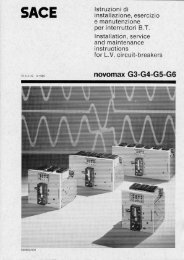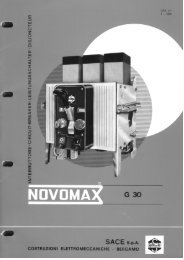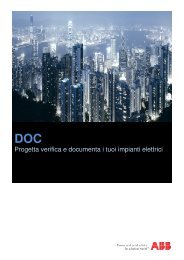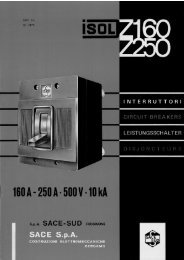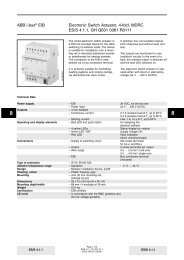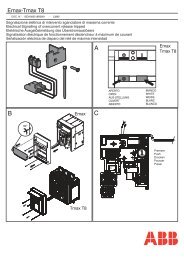ABB i-Bus® EIB/KNX ABB Powernet EIB/KNX
ABB i-Bus® EIB/KNX ABB Powernet EIB/KNX
ABB i-Bus® EIB/KNX ABB Powernet EIB/KNX
You also want an ePaper? Increase the reach of your titles
YUMPU automatically turns print PDFs into web optimized ePapers that Google loves.
<strong>ABB</strong> i-bus ® <strong>EIB</strong>/<strong>KNX</strong><br />
<strong>ABB</strong> <strong>Powernet</strong> <strong>EIB</strong>/<strong>KNX</strong><br />
LEANtouch (monochrome),<br />
SMARTtouch (monochrome, colour)<br />
Type: 6x36/30M…, 6x36/100x…, 6x36/100CB…<br />
ve drive takes approx. 2-3 minutes.<br />
A shorter cycle time than 15 minutes<br />
is therefore not advisable.<br />
b)Floor heating:<br />
The time constant of a floor heating<br />
system is very high. A cycle time of<br />
20 minutes is therefore sufficient.<br />
c)Warm water heating:<br />
Electrothermal drives are frequently<br />
used here. A cycle time of 15 minutes<br />
produces very good results.<br />
d)Electric fan heating:<br />
Cycle times between 10 and 15 minutes<br />
are recommended, depending<br />
on the electric heating and<br />
spatial conditions.<br />
If a two-position controller is used for<br />
heating or cooling control, it is possible<br />
to select the hysteresis by which<br />
the setpoint fluctuates. If e.g. the setpoint<br />
in heating mode is 20°C and the<br />
hysteresis is 0.5 K, the controller switches<br />
on at 19.75°C and switches off<br />
again at 20.25°C. The hysteresis that<br />
is set then depends on how quickly<br />
the heating can heat up the room or<br />
how quickly the cooling cools down<br />
the room as well as how sensitive the<br />
customer is to temperatures. The hysteresis<br />
should not be set too low as<br />
otherwise the valve drive continually<br />
opens and closes. The hysteresis<br />
should however not be set too high as<br />
the temperature fluctuations in the<br />
room are then relatively high.<br />
To increase the accuracy of the control,<br />
the parameter “Lowering of hysteresis”<br />
is used. If this parameter is active<br />
the hysteresis is reduced e.g. every<br />
minute by 0.1 K, if required until 0 K.<br />
The temperature fluctuations are effectively<br />
reduced during the control by<br />
the lowered hysteresis. If a reduction<br />
should be used, it is advisable to select<br />
a reduction that is less than one<br />
fifth of the hysteresis.<br />
e.g. Hysteresis 0.5 K =><br />
Reduction < 0.1 K/min<br />
In certain cases (floor heating), it may<br />
be necessary to install a fast-acting<br />
additional system to enable you to<br />
heat the room up quickly. If the “Additional<br />
heating” is active, the panel has<br />
a second heating system available<br />
with a switching control<br />
(1 bit) or a quasi continuous control<br />
which regulates the heating with the<br />
1-byte values 0% and 100%.<br />
With the parameters “Level distance<br />
from the base level to the additional<br />
level in K” and “Hysteresis (one-sided)”,<br />
it is determined when the additional<br />
level is switched on and when it<br />
is switched off. If e.g. the setpoint for<br />
the second heating level is set at<br />
18°C with a hysteresis at<br />
0.5 K (one-sided), the thermostat switches<br />
on at 18°C and switches off at<br />
18.5°C.<br />
As some valve drives close at a 1-byte<br />
value of 255 or a 1-bit value of 1 and<br />
open at the corresponding inverted<br />
values, the “Effective mode” can be<br />
inverted.<br />
The toggling between heating and<br />
cooling is carried out automatically by<br />
the room thermostat. If this is not required,<br />
the “Toggle between heating<br />
and cooling” can be carried out by an<br />
external, central control via the 1-bit<br />
object “Toggle heating cooling”. In this<br />
setting, the heating or cooling symbols<br />
are permanently visible during<br />
the corresponding operating mode. If<br />
an ON telegram is received at the<br />
operating mode object, the heating<br />
mode is switched on. If an OFF telegram<br />
is received, the cooling mode is<br />
switched on.<br />
Automatic shading<br />
To prevent the room warming up due<br />
to sunlight, automatic shading can be<br />
carried out by lowering one or several<br />
blinds. The object “Shading” is used<br />
for this purpose.<br />
The parameter “Shading setpoint” determines<br />
at which temperature the<br />
blinds should be lowered.<br />
If the temperature falls below the set<br />
shading temperature, no commands<br />
for lowering the blinds are sent. The<br />
blinds could be raised at a specific<br />
time e.g. with a central command.<br />
Group master mode<br />
In rooms such as large open-plan offices,<br />
it can be difficult to achieve effective<br />
control throughout the room<br />
with only one panel operating as a<br />
room thermostat. In such cases, it is<br />
advisable to divide the room into several<br />
zones in which one room thermostat<br />
is used per zone. So that these<br />
room thermostats always use the<br />
same setpoint, there is the possibility<br />
of activating the parameter “Group<br />
master operation mode” for one device.<br />
In this case, this device has the<br />
66 May 2006



